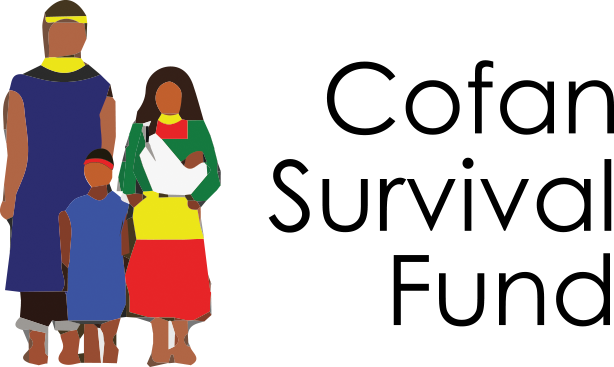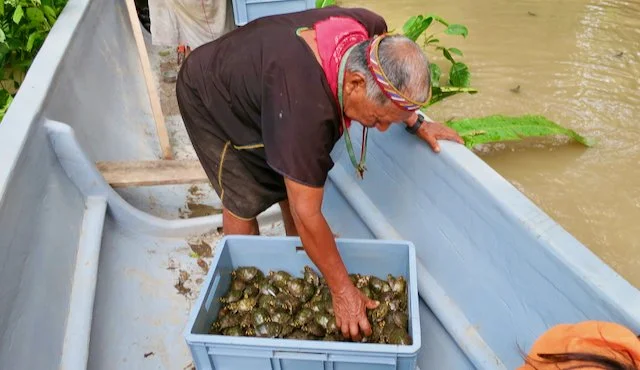Dear Cofan Survival Fund Supporters,
Once again, I find myself writing a newsletter I should’ve sent months ago. To put it simply, we at the Cofan Survival Fund (CSF) are overwhelmed with work and travel. Whether we’re U.S.-based volunteers searching for funding or Cofan activists using that funding to sustain our initiatives in Amazonia, we hardly get a day of rest. But to us, it’s well worth the effort.
Today, I write from the Andes Mountains and Ecuador’s capital city, Quito. Tomorrow, a Cofan family will arrive to stay with me. Others are already here. Some are CSF employees who are using your donations to fight for Cofan lands in government offices, and others are depending on your support to battle illnesses in Quito hospitals. In a week, I’ll be in the forest working with Cofan collaborators to finish research for a book on the role Cofan shamans play in protecting Cofan territory. Two more Cofan individuals—CSF board member Hugo Lucitante and project manager Felipe Borman—are in Leticia, Colombia. With their expenses paid by scholarships, they’re attending an academic conference to share Cofan lessons and accomplishments with Indigenous leaders, human rights activists, and anthropologists from around the world.
In my recent newsletters, I’ve described our important work in the realms of land rights, healthcare, and education. Today, I want to remind you of one of our smaller-scale efforts, but one that is equally essential: our partnership with the Cofan community of Zábalo to save two species of Amazonian river turtles, Podocnemis unifilis and Podocnemis expansa.
Zábalo residents began repopulating the Aguarico River with these threatened species decades ago. With creativity, determination, and the support of people like you, the turtle populations first stabilized and then grew. Not long ago, one could travel the entire Aguarico River and not see a single river turtle. Now, if you’re in Zábalo’s territory, you’ll see hundreds if not thousands sunning themselves on beaches and logs. The turtles are perfect symbols of how an Indigenous community, committed scientists, and international donors can collaborate to return an imperiled planet to health.
Zábalo residents devised their own method to save the turtles. Cofan people have long enjoyed eating river-turtle eggs, but when they realized how few turtles were left, they went into action. 30 years ago, they took the first steps to create what is now a proven process: first, prohibiting the capture of adult turtles; second, locating turtle nests and protecting them from flooding rivers; third, transplanting threatened nests to “artificial” beaches on high ground; fourth, putting newly hatched turtles into pools and feeding them for six to twelve months; and fifth, releasing the turtles into rivers and lakes after they have become strong and large enough to fend off predators. To see what the process looks like, watch this VIDEO from our project manager Felipe Borman.
As usual, Cofan ingenuity worked. The recovery of Zábalo’s river turtle populations is confirmed by everyday sightings, but scientific papers also document the Cofan’s success. In 2005, a Field Museum scientist and three Zábalo residents published “Cofán Indians’ Monitoring of Freshwater Turtles in Zábalo, Ecuador.” More recently, scientists from the World Wildlife Fund and Ecuador’s National Institute of Biodiversity, together with nine Zábalo residents, wrote “Assessment of the Charapa Turtle (Pelomedusoidea: Podocnemis) Community Management Program in Zábalo, Ecuadorian Amazon Region.” Both articles share decades of Zábalo data to describe the power of Cofan conservation.
Zábalo’s success has inspired ecologists, environmental organizations, and Indigenous communities to replicate Cofan techniques. What was once an idea conceived in a remote Amazonian village has become an international model for conservation success. At a time when anyone who cares about the environment can use a dose of optimism, the Cofan are here to assure us that with the right support, Indigenous Peoples can maintain biodiversity and protect forests in ways that will ensure a more sustainable future for us all.
The CSF is a “one-stop shop”: by giving to us, you’re aiding the survival of everything from newborn river turtles, to one million acres of rainforest territory, to two thousand Cofan individuals who are fighting to maintain their health, knowledge, language, culture, and autonomy. With your help, the Cofan will survive another 500 years as a thriving Indigenous Nation that will inspire us to imagine—and create—a world in which cultural and biological diversity are not doomed to disappear.
Against the odds, the Cofan have survived epidemic diseases, voracious extractive industries, and waves of non-Indigenous settlers who want to deforest Cofan land to produce beef, coffee, and palm oil. The great bulk of the credit belongs to the Cofan, but the generosity of individuals like you has played an important role in this miraculous story. As always, the Cofan want us to know that their fight is our fight. If they fail in their struggle, we’ll lose the biodiversity, freshwater resources, and climate-change-mitigating forests that are essential to us all.
Few other organizations work as efficiently as we do. Our U.S.-based nonprofit is an all-volunteer force. Our Ecuadorian team puts your donations to direct use. We don’t have bulky overhead: no do-nothing administrators, no public-relations teams, and no program consultants. In the U.S., we work hard to find funds; in Ecuador, Cofan people know exactly what to do with them. Our operating budget is less than a tenth of similar organizations, yet we believe our accomplishments are ten times as great.
Whether you give $10 or $10,000, know that you’re playing an essential role in the Cofan’s success. If you’d like to discuss what your gift can accomplish, write me directly at michael.cepek@utsa.edu so we can schedule a conversation. I’m always happy to speak to existing and potential supporters. I don’t just donate my time and energy to the CSF, I also donate my money—and I’d like to tell you why that choice was one of the best ones I’ve ever made.
Sincerely,
Michael L. Cepek, CSF President
CSF is a 501(c)(3) non-profit organization, and donations are tax deductible to the fullest extent allowed by law. For gifts of $250 and larger, you will receive a receipt for tax purposes.



